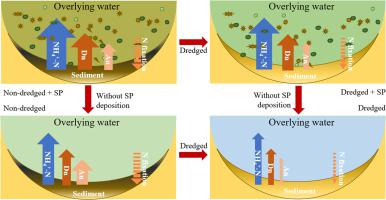Journal of Hazardous Materials ( IF 12.2 ) Pub Date : 2020-12-02 , DOI: 10.1016/j.jhazmat.2020.124691 Jicheng Zhong , Shuailong Wen , Lu Zhang , Jianjun Wang , Cheng Liu , Juhua Yu , Lei Zhang , Chengxin Fan

|
Internal nitrogen (N) loading of lakes is commonly controlled by sediment dredging, although its comprehensive effect on internal N loading remains unclear. Herein, we examined the long-term effects of sediment dredging on internal N loading from a new perspective on the N budget at the sediment–water interface (SWI) through a simulation of field dredging performed by incubating intact sediment cores from a shallow eutrophic lake (Lake Taihu). We further evaluated the role of settling particles (SP) in the recovery of N cycle processes after dredging and its potential impact on the N budget. Our results demonstrated that dredging could help reduce organic matter and total N in sediments; improve the redox environment of the SWI; slow down N mineralization, N fixation, denitrification, and anaerobic ammonia oxidation (anammox); and alter the N budget at the SWI and the contribution of various N cycle processes. However, the input of SP enriched in fresh organic matter and N could accelerate the recovery of N cycle processes at the SWI, reducing the variation in the N budget and the contribution of each N cycle process caused by dredging. Dredging significantly reduced the N flux at the SWI, which was evident from the reduction of inorganic N release flux and N removal through denitrification and anammox. Therefore, sediment dredging has its advantages and disadvantages in managing internal N loading in lakes. To maintain a long-term control on the release of internal N through sediment dredging, measures should be taken based on the in-lake and watershed to inhibit the inflow and settlement of particulate matter.
中文翻译:

沉积物疏water和沉降颗粒物改变沉积物-水界面的氮平衡:富营养化管理的利弊
湖泊内部的氮负荷通常由泥沙疏controlled控制,尽管其对内部氮负荷的综合影响尚不清楚。在这里,我们通过对浅水富营养化湖泊中完整的沉积物核心进行孵化而进行的现场挖泥模拟,从沉积物-水界面(SWI)上的N收支的新角度研究了泥沙疏on对内部N负荷的长期影响。 (太湖)我们进一步评估了沉降物(SP)在疏after后恢复N循环过程中的作用及其对N预算的潜在影响。我们的结果表明,疏could可以帮助减少沉积物中的有机物和总氮。改善SWI的氧化还原环境;减慢氮矿化,固氮,反硝化和厌氧氨氧化(anammox); 并更改SWI的N预算以及各种N循环过程的贡献。然而,富含新鲜有机质和氮的SP的输入可以加快SWI处N个循环过程的恢复,从而减少N预算的变化以及每个挖泥过程对N个循环过程的贡献。疏WI显着降低了SWI处的N通量,这可以通过减少无机N释放通量以及通过反硝化和厌氧氨氧化去除N来证明。因此,沉积物疏in在管理湖泊内部氮负荷方面有其优点和缺点。为了长期控制通过沉积物疏of释放内部氮,应在湖床和集水区的基础上采取措施,以防止颗粒物的流入和沉降。











































 京公网安备 11010802027423号
京公网安备 11010802027423号